In pictures: The most memorable spacewalks in history
Venturing out into space wearing nothing but a spacesuit is a daring act in itself. But over hundreds of spacewalks since 1965, there are a few that stand out because of their length, or what the astronauts did during those times outside the spacecraft. Here are a few of the more memorable ones.
First spacewalk (March 18, 1965)
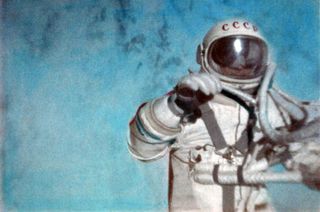
Alexei Leonov was the first person to perform a spacewalk. The Soviet Union cosmonaut was outside for about 20 minutes and then encountered a problem getting back into the hatch because his suit had expanded. Leonov bled out some of his air to return.
"It was the alpha and the omega: the first, and very nearly Leonov's last, spacewalk," said Nicholas de Monchaux, an associate design professor at the University of California, Berkeley who wrote a book called "Spacesuit: Fashioning Apollo."
Related: Astronauts mourn Alexei Leonov, the world's 1st spacewalker, while on a spacewalk of their own
First U.S. spacewalk (June 3, 1965)
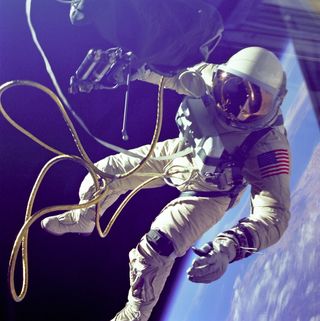
Three months after the Soviet Union, NASA's Ed White did the first U.S. spacewalk and also spent about 20 minutes moving in space with the help of a gas gun. de Monchaux added that the image of a person floating alone in space was a sought-after icon for propagandists who wanted to evoke ideas of angels. As such, the White spacewalk "was also illustrative of the way in which the visual iconography of space travel was part of the battle of the Cold War."
Gallery: The 1st American spacewalk in NASA photos
Farthest spacewalks from Earth (1971-72)
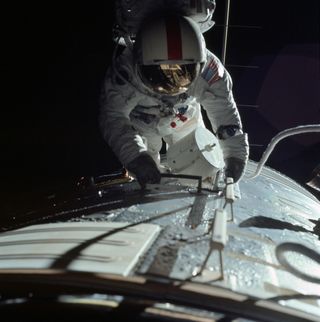
One astronaut on each of the Apollo 15, 16 and 17 missions dared to venture outside while the crews were on their way back to Earth from the moon — making them the farthest-flung EVAs ever performed by humans. What also was unique about these spacewalks is the role of a second crew member that acted as an observer, said Jim Oberg, a space historian who frequently comments for NBC. "On each one, a second crewman was standing up in the hatch with time to look out over the entire universe," he told Space.com.
Get the Space.com Newsletter
Breaking space news, the latest updates on rocket launches, skywatching events and more!
Apollo 15 command module pilot Al Worden did the first so-called "trans-Earth" EVA on Aug. 5, 1971, with the assistance of lunar module pilot James Irwin. On April 25, 1972, Apollo 16 command module pilot Ken Mattingly did the second transearth EVA with the help of lunar module pilot Charles Duke. Apollo 17's transearth EVA was conducted by command module pilot Ron Evans, who was assisted by lunar module pilot Harrison Schmitt, on Dec. 17, 1972.
First untethered spacewalk (Feb. 7, 1984)

Using a kind of jetpack called the Manned Maneuvering Unit, NASA astronaut Bruce McCandless did the first untethered spacewalk during STS-41B. He first tested it out inside the payload bay of the space shuttle Challenger, then flew it 320 feet (98 meters) away from the space shuttle. "That was really the first time you had a human being operating like one of those angels, moving him or herself in trans-Earth space," de Monchaux said.
First all-woman spacewalk (Oct. 18, 2019)
On Oct. 18, 2019, two NASA astronauts became the first women to go out on a spacewalk unaccompanied by men. Expedition 61 flight engineers Christina Koch and Jessica Meir spent 7 hours and 17 minutes working to replace a battery charge/discharge unit — a piece of hardware connected to the space station's solar arrays that is used to charge the station's batteries — that had failed after being installed during another spacewalk one week earlier. Koch and Meir ended up doing a total of three spacewalks together during Expedition 61.
NASA had originally planned to do the first all-female spacewalk just a few months earlier in April 2019, but that historic event was canceled when there was only one spacesuit on board the International Space Station that would fit on the women's smaller frames.
Full story: NASA astronauts make history with 1st all-woman spacewalk
Shortest spacewalk (Sept. 3, 2004)
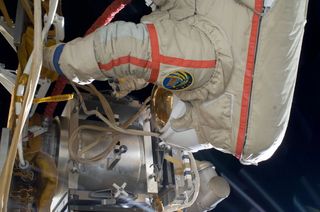
The shortest spacewalk in history was only 14 minutes, which occurred when U.S. astronaut Michael Fincke was working on construction for the International Space Station. A pressurization problem occurred in his tank and he and his crewmate, Gennady Padalka, were forced to abort. Padalka and Fincke were using Russian Orlan suits due to cooling issues in the U.S. suits, according to the Washington Post.
Longest spacewalk (March 11, 2001)
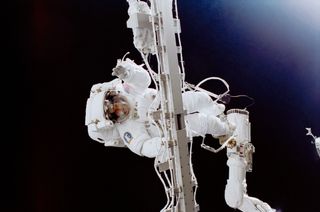
The longest spacewalk was 8 hours, 56 minutes and took place during STS-102 on March 11, 2001. NASA astronauts Susan Helms and Jim Voss got the Pressurized Mating Adapter ready for a move from the Unity module to clear the way for Leonardo, a temporary module that brought supplies to and from space. They also removed an antenna and moved a lab cradle assembly from space shuttle Discovery to the International Space Station.
Spacewalk with the most people (May 13, 1992)

Part of STS-49's work in 1992 was supposed to capture an errant satellite, Intelsat VI, which was stuck in low Earth orbit instead of the intended geostationary orbit. But the capture bar intended to grab the satellite didn't work during two EVA attempts with two astronauts, Pierre Thuot and Richard Hieb, on May 10 and 11. To lend an extra hand, NASA authorized a third astronaut, Thomas Akers, to go outside — the first and only time so far three astronauts have worked on an EVA at the same time.
Most dangerous Russian spacewalk (July 17, 1990)
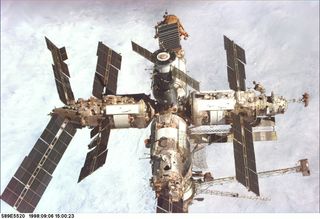
One of the spacewalks most deserving of "needing some respect" came during a spacewalk on space station Mir with cosmonauts Anatoly Solovyev and Aleksandr Balandin, according to Oberg. The 1990 spacewalk to repair insulation on a damaged Soyuz spacecraft turned dangerous when Mir's hatch wouldn't close after the work was completed. The cosmonauts were forced to use a backup hatch at the Kvant-2 module. "Probably the closest case we know of a near-death Russian spacewalk," Oberg said.
Most dangerous U.S. suit spacewalk (July 16, 2013)
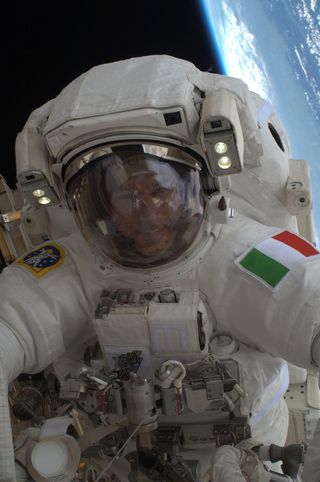
Minutes after European Space Agency astronaut Luca Parmitano left the hatch for an International Space Station Expedition 36 spacewalk on July 16, 2013, he felt water pooling at the back of his helmet. Once NASA realized the leak couldn't be contained, it ordered Parmitano and his crewmate, Chris Cassidy, back inside. By the time Parmitano was back inside the station, the water was in his ears and eyes. The leak was later traced to a problem in the backpack. Spacewalks were suspended for months while NASA investigated the situation and made changes to the suit.
Most daring space station repairs (Skylab and ISS)
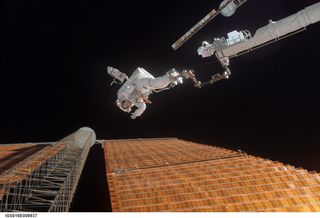
There have been two exceptionally difficult space station repairs that astronauts tackled during spacewalks. One series took place in May and June 1973, when astronauts on the first Skylab mission did repairs to their station, which was damaged during launch. Among their substantial work, they deployed a solar shade to keep the overheating station cool.
A second daring spacewalk, on Nov. 3, 2007, saw NASA's STS-120 astronaut Scott Parazynski ride a robotic arm to an International Space Station solar array — an array that was damaged during unfurling — to do tricky repairs while the array was still powered.
Editor's note: This article was originally published Aug. 10, 2015 and updated Feb. 6, 2020.
- FAQ: How do astronauts take spacewalks?
- Gallery: The best astronaut selfies in space
- How NASA spacesuits work: EMUs explained (infographic)
Follow Elizabeth Howell on Twitter @howellspace. Follow us on Twitter @Spacedotcom and on Facebook.

Join our Space Forums to keep talking space on the latest missions, night sky and more! And if you have a news tip, correction or comment, let us know at: community@space.com.

Elizabeth Howell (she/her), Ph.D., is a staff writer in the spaceflight channel since 2022 covering diversity, education and gaming as well. She was contributing writer for Space.com for 10 years before joining full-time. Elizabeth's reporting includes multiple exclusives with the White House and Office of the Vice-President of the United States, an exclusive conversation with aspiring space tourist (and NSYNC bassist) Lance Bass, speaking several times with the International Space Station, witnessing five human spaceflight launches on two continents, flying parabolic, working inside a spacesuit, and participating in a simulated Mars mission. Her latest book, "Why Am I Taller?", is co-written with astronaut Dave Williams. Elizabeth holds a Ph.D. and M.Sc. in Space Studies from the University of North Dakota, a Bachelor of Journalism from Canada's Carleton University and a Bachelor of History from Canada's Athabasca University. Elizabeth is also a post-secondary instructor in communications and science at several institutions since 2015; her experience includes developing and teaching an astronomy course at Canada's Algonquin College (with Indigenous content as well) to more than 1,000 students since 2020. Elizabeth first got interested in space after watching the movie Apollo 13 in 1996, and still wants to be an astronaut someday. Mastodon: https://qoto.org/@howellspace
